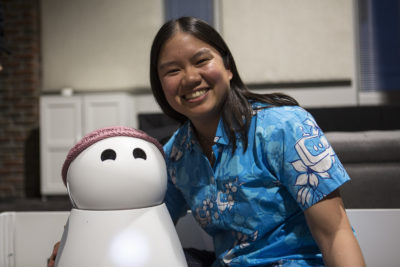We sat down with Kaijen Hsiao, CTO at Mayfield Robotics. She and her colleagues (led by veteran startup CEO Mike Beebe) have been working for the past two years to develop a home robot. Why? What will it do? And where will this whole robot craze end up taking us?
First thing first…. you’re probably going to want to hang out with Kuri.
Reviews of your product, a home robot named Kuri, keep calling it adorable. Was that your goal, and by the way, did you like the movie Big Hero 6, which stars a particularly adorable robot?
We love all the adorable robot movies. And we love when people say our robot is adorable, because we worked really hard on that. One of my favorite things about Big Hero 6 is that the stars are robotics grad students. That is true of no other movie I know. In one of the scenes, you even see a McMaster-Carr catalog in the background.
How did you get Bosch to support this speculative endeavor, to build a home robot company?
Sarah [COO Sarah Osentoski] and I were both robotics researchers at the Bosch Research Institute in Palo Alto, and there was a need-finding exercise going on between our group—the robotics researchers—and the User Experience group.
The idea was to try to figure out what robots could be put in the home that were something between a Roomba and Rosie the Robot [from the Jetsons, a 1960’s animated TV show], because technologically we’re just not ready to make Rosie the Robot yet, in the near term anyway. What could we make that users would accept into their homes and that would be interesting? So, there was a lot of interviewing people about what they would want and expect.
Initially, the concept was focused around home security. We put together a proposal to start an entire company to make home-security robots. There’s a program at Bosch called the Bosch Startup Platform, where you can propose new ideas and potentially start new startups.
How did submitting that proposal make you feel?
It was exciting. What we were floating was very, very different than what we were doing before. We were building components that may or may not see the light of day. Whereas this was proposing “no really, we’re going to build a company to go and sell directly to consumers in large quantities!” This was something we’d never had experience with before—we were both researchers—but it was something we were very interested in.
How much of your own fancy and imagination has informed the design of Kuri, your robot?
Quite a bit, especially where the robot has kind of evolved to. It started out more as a home security concept and not necessarily even being an adorable robot. Talking to users more after the company launched, we heard a lot of things like “Well, by the time someone’s in the house, it’s kind of too late, isn’t it?”
And we heard a lot more things like “What does the robot do while I’m at home?” At first our answer was like, “He sits quietly on his dock until you go away, because you don’t need him while you’re not at home,” and they say would say, “But what does he do while I’m at home?” It was clear that they all wanted the robot to be entertaining and personal and something they could show off to their friends.
What I want it to do is to vacuum. I very much would want it to vacuum.
[Awkward pause.] There were a lot of people who were saying they want it to vacuum. We did a lot of rejecting adding additional features to our robot. There are things the robot could do, but there are things the robot should do and the robot should do only a couple things well and not do everything. No, it’s not going to vacuum your home, there are other robots for that. This robot is a companion robot.
OK fine. Well, what are some of the other things you decided Kuri would NOT do?
A lot of robots in our space have chosen to have the robot speak English, the way Alexa does or Google Home, but we have chosen not to do that. Our robot speaks robot. She makes adorable beeps. It’s kind of like having a Wal-E or R2D2 in your house. In particular, it sets the expectations that the robot should be like an intelligent dog, not like an intelligent butler, say. Or not even like an intelligent three-year-old, because artificial intelligence isn’t really even sophisticated enough to keep up with three-year-old dialog right now.
Of the 55 people working at Mayfield Robotics now, whose job is it to make sure Kuri stays adorable?
It’s something everybody does in that the effort it takes to make the robot adorable and keep the robot adorable is a systemic, giant effort. It’s a design thing, a hardware thing, an everyone thing. But software-wise, we contract with an animator named Doug Dooley, and he helps with the animations Kuri has and a lot of the things that make Kuri lifelike. For instance, Kuri should express intentions before moving. Doug works with Michael Voight, an experience designer. A lot of the robotics engineers take it from spec and turn it into reality.
We notice that 21 of the 55 people who work at your company are women. Is that common among robotics startups.
It’s definitely unusual. Most robotics companies don’t have nearly as many women as we do. We try very hard to keep diversity in our company high. It does make a huge difference, both in terms of our products and in terms of our culture. In terms of our product, diversity makes it more likely that your product is going to appeal to more people. In terms of company culture, we promote really good work-life balance and family friendliness. It just makes working more pleasant and it allows us to attract a lot of people who are put off by other companies that don’t have those policies.
I see you’re hiring. What are you looking for?
Of course, we’re looking for people who are highly qualified, but in general we are also looking for people who love robots, and in particular, our robot. People who think she’s adorable and exciting, and who are excited about building things and shipping them.
How did you first get interested in robotics?
When I was in high school, I had a physics teacher and he taught almost more engineering than physics. We did a lot of projects. We made mousetraps and Rube Goldberg machines. I really enjoyed that class and building things, and that’s why I went into engineering.
When I was an undergrad, I was a mechanical engineer and I was very interested in the robots coming out of MIT. Cynthia Breazeal had Kismet and MIT Leg Lab had all these adorable hopping robots. All of them made me think it would be really great to make robot pets someday. I couldn’t have a dog for a long time and I wanted a dog. And in college of course they don’t allow pets, and so I thought if could have robot pets, that would be cool.
Wait, did you make a robot pet as an undergrad?
I didn’t exactly make robot pets as an undergrad, but I did do a senior thesis on a dynamic, hopping kangaroo robot, because I thought that would be super adorable, and dreamed of someday having pet kangaroo robots hopping around my home.
Is Kuri a he or a she?
I tend to switch back and forth. We like to say you can choose, but Kuri is not an “it.” It was very intentional to make it as androgynous as possible, in look and in sound and personality, so that people could choose.
So, no eyelashes?
No, but kids love to dress up Kuri. If you put a bowtie on his neck, he looks male, but if you put it on the head, like a hair bow, she looks like a girl. I love that this simple wardrobe change can change the gender.
What about Kuri alone in a room with a six-year-old?
We’ve done a lot of testing around kids. I don’t have kids myself, but I hear they like to cover their hands with things like jam or peanut butter and smear them on things. So, for instance, the eyes didn’t used to have plastic shields. I was like, who would stick their fingers there? Sarah has a son Zach, and he came in one day and saw the robot for the first time and the very first thing he did is run to the robot and stick his thumb in the eye.
I don’t have kids, but I have two cats and a bunny, and so for me, Kuri is basically a pet sitter. When I go away, I want Kuri to drive around and take pictures of my cats and my bunny.
Have you surprised any of your guests, by having a robot?
I don’t think I’ve had any houseguests over when Kuri was there, but I did surprise my cats.
When will they be ready to ship?
The first batch [of Kuri robots] will ship in December, but people who pre-order today won’t get them until spring of next year.
How did you arrive at the price, $799?
The goal was to make robots people can afford. Once you go above a thousand dollars, it’s hard to sell in large quantities. It’s a luxury, but a lot of people can afford Kuri if they really want one. So, we started with the price and then asked, what can we make the robot do for this amount of money?
Who will your customers be, do you think?
I would describe them as people who share the robot dream. I’m always surprised by how many people are in this category. People who watched Star Wars or Wall-E and thought, Oh my gosh, I would love to have a robot companion of my own like R2D2 or like Wall-E. And they look at Kuri and they say, “Oh, Kuri is that robot finally!” That’s part of why they want to own Kuri. I used to think that was limited to geeks and science fiction lovers, but actually it’s pretty common.











